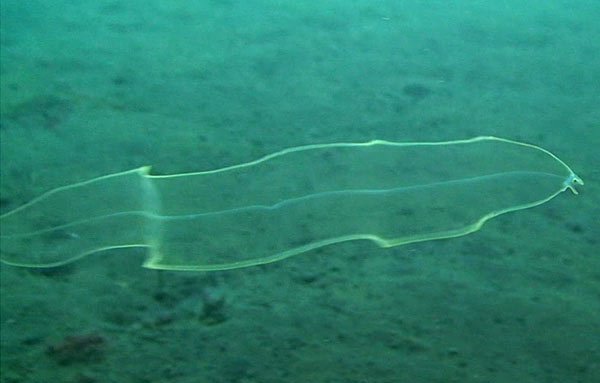Large Muraenid Leptocephali
The stunning image, shows large leptocephali filmed by divers at three locations within the Indonesian Archipelago from 2009 to 2011.

© Henny Rutgers
The observations were made from December to April in Lembeh Strait adjacent to north-eastern Sulawesi Island, at Ambon Island and at Bali.
The video clip showing the four leptocephali that were filmed by various divers is associated with a published paper by Dr Michael Miller, entitled 'Observations of large muraenid leptocephali in coastal Indonesia: locations of sightings and behavior of the larvae.'
Leptocephali are transparent because they have only a thin layer of muscle over a mucinous pouch inside the body. The pouch contains glucosaminoglycan (GAG) compounds that form a transparent jelly-like substance. The GAGs are converted into tissue during metamorphosis, and thus in addition to being transparent, they are also an energy storage material.
The leptocephali are about 300 - 400 mm long and appear to be metamorphosing larvae of some type of moray eel of the family Muraenidae. The morphological similarities between these leptocephali and Ribbon Eels, Rhinomuraena quaesita, suggest they may be Ribbon Eel larvae.
View the Moray Eels list.
Learn more about the Ribbon Eel.
View an image of the head of a metamorphosing muraenid leptocephalus.
Read about Dr Miller's research during his 2009 visit to the Australian Museum.
Thank you to Rob Rutgers, Barry Haythorne, Tunc Yavuzdogan and Seishoku Obata who recorded video footage and to Tony Wu who prepared the movie (see Tony's video of giant mottled eels in Ambon).
Reference:
Miller, M. J., R. Rutgers, B. Haythorne, T. Yavuzdogan, S. Obata, T. Wu, H. Rutgers, J. Powell, and K. Tsukamoto. 2013. Observations of large muraenid leptocephali in coastal Indonesia: locations of sightings and behavior of the larvae. Marine Biodiversity Records 6:e82, 1-8.

